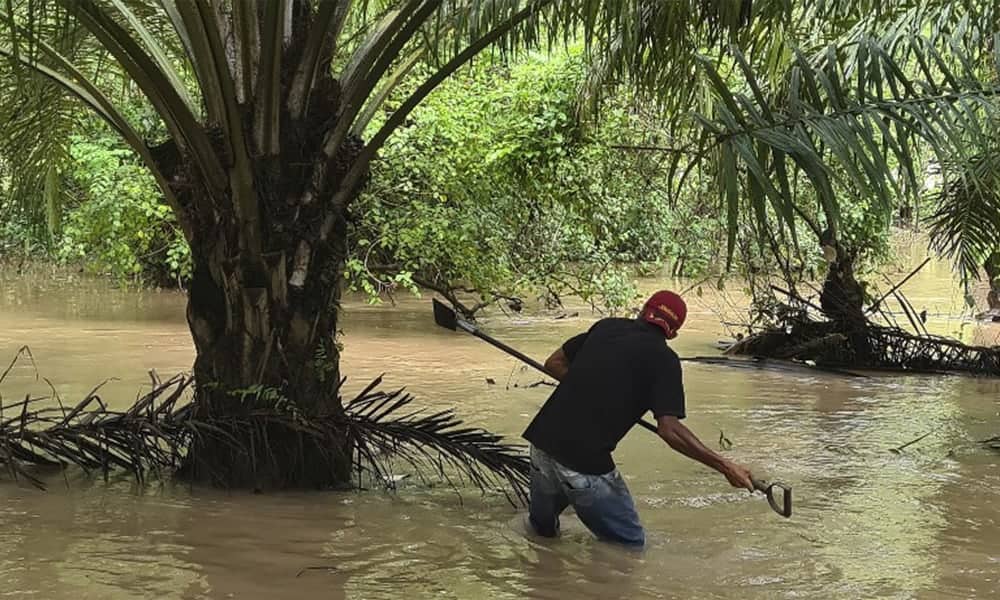Miguel rescued only two ears of corn from his corn plantation, still covered by chocolate water. The Honduran farmer was a victim of tropical storm Julia, which hit Central America a month ago, where weather phenomena are increasingly recurrent.
Julia entered Nicaragua on October 9 as a category 1 hurricane, passed through El Salvador as a tropical storm and dissipated in Guatemala.
The rain bands overflowed the mighty Ulúa and Chamelecón rivers, causing the greatest damage in the Sula Valley in northern Honduras, the area most vulnerable to weather phenomena.
Death and Crops Washed Away
According to government agencies, Julia left about fifty people dead in the four countries, as well as thousands of hectares of crops damaged.
The seven hectares of Miguel Mejía, 58, Antonio Alemán, 53, and eight other Honduran farmers, are 30 kilometers from where the Ulúa overflowed, near El Progreso, some 200 km north of Tegucigalpa. That is where the floods reached.
A month later, the panorama in that area is desolate: the homes of thousands of very poor people covered with earth and other debris washed away by the currents, which also swept away basic grain crops, African palm, bananas, cassava and other products.
“We lost the crop. I could only locate about two half-good cobs and the others are totally rotten,” complained the farmer. “We are going to have a food crisis,” deplored Miguel, who lives with his wife and two grown children.
He estimated the losses at more than 400,000 lempiras, about US$16,000, for the ten farmers, who will not be able to plant in the second cycle of the year because the land is still flooded.
The work of two annual cycles is “to have the maicito to eat the tortillas and help themselves somehow with what they sell of what they harvest,” he explained.
After the losses, Miguel buys food with money he receives from fixing fences damaged by the currents. There “they are giving us a little salary (…) to be able to survive”.
For Antonio, the water covered his house up to the roof. “We planted with purchased seed, we fertilized and we lost all that,” he complained.
Now the farmer works in an African palm cooperative. He is also repairing fences, mowing and cutting fruit, where he is paid $10 a day. “That’s where we’ll be working, for the time being”.
Another farmer in the area, Camilo Chávez, 64, said he manages “to eat with the help of some friends, and the municipality, which has invited us for a little bit of food”.
Too much water
In El Salvador, one of those affected was Victor Carranza, 44 years old. He lost his one-hectare crop in El Zamorano, about 100 km southeast of San Salvador.
“That’s where you’re left even more screwed, without any resources to be able to have your corn,” he said. He is hoping for a government grant to plant again.
“There has been too much water (…) this year has been quite copious, there has never been water like this year,” deplored Alfredo Hernández, 51, also a Salvadoran farmer.
In Nicaragua, the Ministry of Finance and Public Credit estimated the losses caused by Julia in production, environmental damage and infrastructure in health, education, telecommunications, energy, water and sanitation at US$ 367.8 million.
Guatemala’s Minister of Agriculture, José Ángel López, counted among the effects of Julia “60,000 hectares affected at different levels, including corn, beans, cardamom, coffee, bananas, plantains and pastures”.
“All the corn crops were lost, because that’s all we work here (…) we only managed to get a little bit,” lamented farmer Elías Coc, 31, father of five children, resident of the village of Santa Marta Salinas, in the north.
Climate Change
“The big rainfalls have occurred every 20 years, but this time it had only been two years” since tropical storms Eta and Iota. “It had been 24 years since Mitch,” Miguel recalled.
After Hurricane Mitch, which hit in 1998, the worst climatic tragedy Central America has ever experienced, the Honduran authorities built earthen walls on the banks of the Ulua and Chamelecon rivers to protect the populations.
In 2020, the floods caused by storms Eta and Iota broke fragments of these barriers and the rivers overflowed into the populations of the Sula Valley, the most booming productive area of Honduras, a country of 9.6 million inhabitants, with more than 70% living in poverty.
“Climate change is deeply linked to development and human well-being. If left unchecked, its impacts could push 132 million people into poverty in the next 10 years,” warns a July 2022 World Bank report.






